#cascadia bioregion
Text
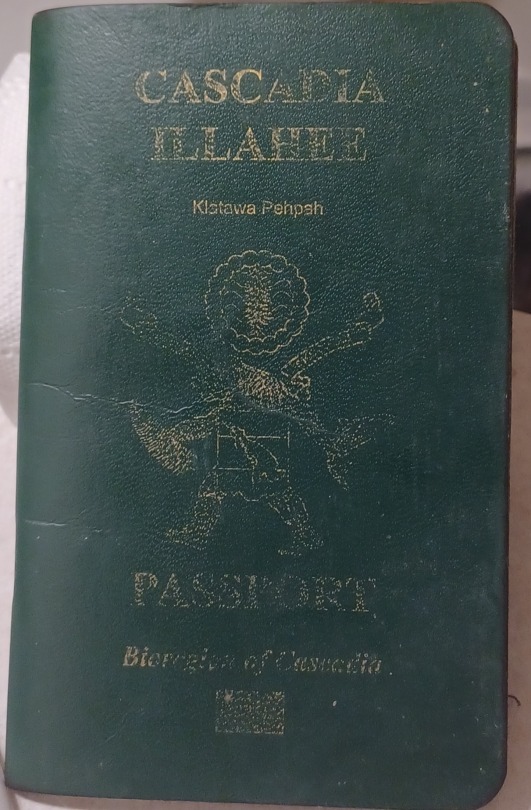


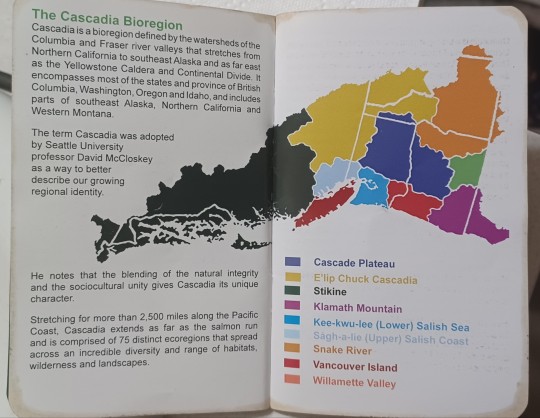
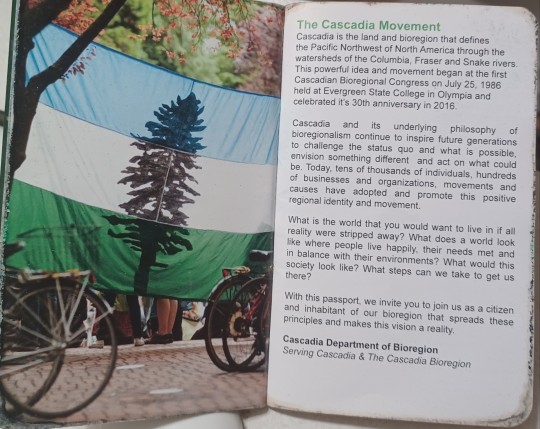
Time for a serious reality check!
0 notes
Text
Cascadian pig of the month! Terry Emmert, worth 200 Million dollars, buys up properties in many PNW Cities! In Aberdeen Washington he is letting many properties sit without use and is renting out properties to shops for so much that they are being ran out of business! Look at this POS!

#cascadia bioregion#cascadia#Cascadian#anti capitalism#socialist#communism#leftism#cascadian pig of the month
0 notes
Text



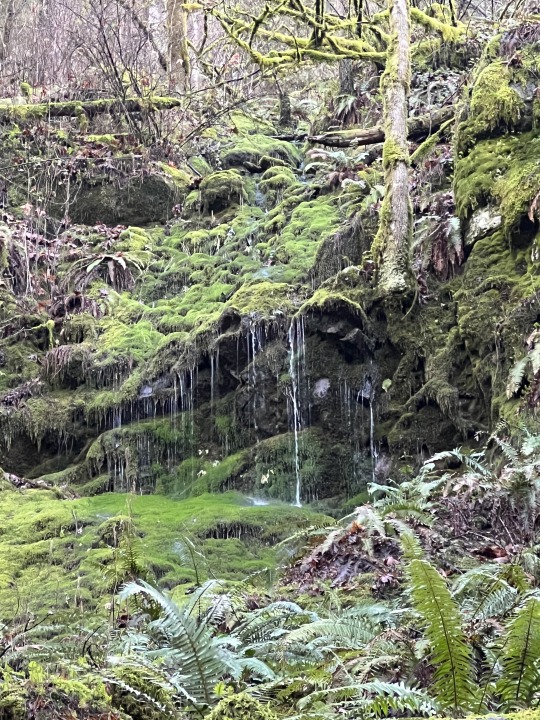
January 1st 2023
I wanted to be in the presence of other beings.
I went to a trail located on the mountains that approach the settlement of Issaquah. The location is known by the dominant society as Poopoo point or Chirico trail; It depends on who's asked. I knew it first as an abstract location during my years in high school. I knew my peers would frequent, and after a google-search, that it was also a paragliding location. I hadn't frequented the mountains until recently. When I take Flex shifts from the amazon-facility in Maple-Valley, I often travel to Issaquah or the settled forests of the Eastside; driving past this face of mountain.
I parked across the street of the busy road, Venmo'd the owners of the lot, and began to take note of the other individuals that also chose to hike on the first day of the year. I greeted others as often as I could, noting that not everyone was excited to say hello. In hindsight, I remember that PNW hiking etiquette may have changed throughout the pandemic. I shift my focus shifted to my breath, pace, and the landscape.
-
In the forest I saw groves of only one species I was confident I could identify, Birch. As a senior-undergraduate chemistry student, I wrote a paper on a chemical-species, member of the equilibrium involved n the trees white-complexion. I hope that through this blog, I can return to it and repurpose it as a piece of science-communication.
-
I saw the watershed flowing down the rocks above me and many streams below me (picture 4). In the moment I was afraid to consider that the face of the watershed I encountered was its expression of run-off and depletion; that perhaps too forest dried during the past summer, and left life there unable to reservoir water effectively for the approaching summer. I told myself to ignore my climate-anxiety and be present with our changing earth. I let myself be happy to have encountered one of many facets of the watershed that scattered the steep forest floor, water falling over rocks, in such a striking manner.
-
When I emerged from the forest and into the clearing of the mountains face, I emerged and greeted sun's warmth, deeper than I had when I entered the forest. The heat felt kind on my aching body.
-
I clung my hammock on an entrance to the forest away from others. I spent a few hours in my hammock, attempting to keep myself warm with the provided heat of the sun, and the absence of it in its shadow. There, I read the chapter Maple Sugar Moon of Robin Wall-Kimmerer's Braiding Sweetgrass.
I found beautiful the reverence Wall-Kimmerer offers homes and its past occupants. In my gazes with the skyline, I considered a home to be a place of ritual and remembered the chapter 'An Offering', where she recounts summers spent canoe-camping in the Adirondacks, and a homemade-ritual of offering the first sip of brewed coffee to the earth. As an adult, her father shared the ritual may have been sourced from the coffee grounds picked up from the boiling water from the bottom of the kettle, in need of being cleared from the spout. She shares a belief that rituals are the union of the mundane to the sacred. I realized I believed her through the beauty I saw in her reverence to a home as place of ritual.
-
On my way down I greeted a young grove of trees I assumed planted after the mountaintop had been cleared from logging; the scars of the act were scattered across the mountain. The vapors of a cloud passed through the tall trees, providing luminance for the rays of sunlight that managed to pierce the canopy. I rested to appreciated it, or I appreciated it to rest (picture 3).
-
When I approached the forest entrance I started from, I noticed the presence beings I had not noticed before. A white fungus that emerged from the root soil of a decaying tree (picture 1). I was very excited about this.
-
Walking towards my car, I faced the mountain and took a picture of the crown of sun that pierced the young forest at the summit (picture 2).
-
-
Mi abuelo me dice mucho que le da mucha felicidad que tengo una rutina con qual vivir mi dia a dia. Me dice que el trabajo es un vicio, y lo entiendo. Cuando uno trabaja, uno tiene tiempo durante su día para ser completo durante la repetición de algún ritual.
Tengo la creencia de que aunque la praxis de mis mayores se deriva de las enseñanzas pervertidas del colonialismo y su esfuerzo por reclutarnos para ayudar a su reproducción, las palabras de mis mayores todavía están guiadas y moldeadas por un anhelo de ritual. Pienso que los rituales nos dan algo del universo de qual nuestra perception se puedo apoyar para crecer mas allá del miedo. Desarrollamos regulation en nuestros cuerpos y conocemos la seguridad: el typo de regulación que solo se puede encontrar cuando nuestros rituales nos dan perception calmada de lo que es grande, lo que cambia los tiempos, y guia nuestro paso
-
My grandfather tells me that it makes him happy to see me practice a routine as I approach my day to day. He is also very proud that I have accepted the burden of labor. My grandfather tells me that labor is a vice, and I understand. When one labors, one has opportunity to practice presence in the repetition of some task. One practices a ritual.
I have the belief that though the praxis of my elders is derived from the perverted teachings of colonialism and it's effort to recruit us to aid it's reproduction, that words of my elders are still guided and shaped by a yearning for ritual. I think that rituals give us something of the universe that our perception can cling onto. Some support to help regulate safety into our bodies. A type of regulation that is only found when our rituals grant us calm perception to observe what is grand, of what changes the times, and guides our step.
-
José
#environment#earth#earthmother#climate#watershed#fungus#photography#journal#pacificcoast#cascadia bioregion
1 note
·
View note
Photo
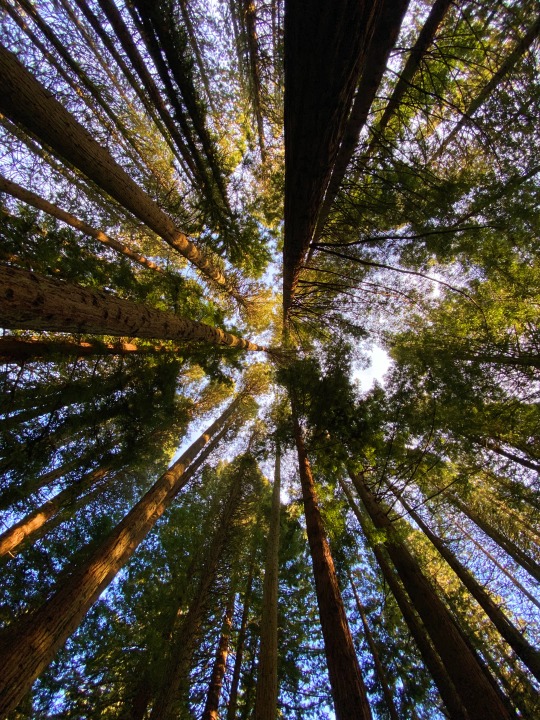
residents (redwoods, multiple species)
hoyt arboretum, portland oregon
february 9, 2022
when i was a child, nature drew me in for connection. it was the dark spaces, dynamic, behind the leaves of the ferns; the rush of snowmelt in the creekbeds in the spring; the two-syllable song of the crows who almost seemed to be saying my name. i was allowed to wander freely in the wilderness behind our house; climb and scramble over the logs that bridged the creeks; forge new paths to favorite spots when the snowmelt obscured the old routes; search for fossils in the rocks and trace them with my fingers; to pick and eat wild blackberries, letting the thorns scratch my legs and my arms. we were taught to respect living creatures, but we were never taught to fear nature, and so to me, nature was safe. even though sometimes i would run, breathless, from the coydogs or raccoons i imagined lurking in the shadows, the natural world itself was a true refuge: a place where i could go to regulate my nervous system, though i never thought of it in those terms. as a kid, it just simply was what it was: a deep, safe, and loving relationship that i didn’t think of as remarkable in the slightest.
while training as a therapist, i found myself drawn to questions of our nervous systems and our maps of attachment. it didn’t interest me much during the academic portion of my training, but during my clinical year, it became increasingly clear to me that attachment (in other words, relationship) is foundational to our ability to cope with stress. more than that, it’s foundational to our ability to feel a sense of connection, belonging, fulfillment, meaning, and self-regard - all things i consider part of our fundamental rights as living beings on this planet. attachment and polyvagal theorists believe that we are wired to seek out connection, and that ruptures and wounds to our attachment maps (due to trauma, loss, intergenerational wounds, etc.) can lead to barriers in our ability to feel safe in relationship to others. following attachment wounds, relationships can feel existentially unsafe, but at the same time, we’re wired for connection and in fact, need it to survive in this world. it’s a predicament, to be sure, but one that can be attended to, soothed, and healed.
what does all this have to do with this project, or with the ecological crisis? it’s because there is a theory that our attachment maps extend beyond our human relationships, and into our relationships with animals, other living creatures, and with the natural world itself (which is inextricable from the rest of the world, despite me currently naming it as distinct). ecopsychologists and writers such as andy fisher, robin wall kimmerer, david abram, and jenny odell have posited that our relationship to place and to other living beings is essential to our ability to live connected, full lives, and some theorize that ruptures in our relationships to nature can contribute to a whole host of suffering: mental health symptoms, relational disruptions, depression, anxiety, dissociation, etc. it also freezes our ability to respond to the ecological crisis we are currently facing: how can we attune and respond capably to our surroundings when we have been so socialized to live in disconnection? how do we live in right relationship with the world when we can see that there is so much suffering occurring? how do we live in our bodies when the world is hostile to all of us, not only to “nature”? it becomes easier on our nervous systems to simply disconnect.
but we never truly disconnect. we can’t - we are wired for connection. instead, we live in a perpetual state of stress, because disconnection indicates a freeze response, which is a state we reach when it becomes apparent that fight or flight will be useless. but even though we freeze and disconnect, we are still in a state of nervous system distress where our bodies are deeply attuned and vigilant to the threat we perceive around us. when “nature” is threatened, we are threatened - because we are nature, and we live in relationship to nature - and our bodies are acutely aware of this threat, even when our conscious minds are not.
it seems to me that the work of this moment is repairing that connection to the world, to each other, and to ourselves. how do we come home to ourselves and to this planet? it’s not an easy question to answer, and repairing our attachment wounds, while transformative, can feel like a scary process at times. it requires us to be vulnerable, which in turn requires us to be open to grief and loss.
there is a lot to grieve right now. we are living in a world of loss. but opening up to these experiences also feels like coming home. it can be a profoundly moving, grounding, and life-changing process to move through fear and open ourselves up to the joy and the grief of true connection and love. because grief is love - you do not grieve what you do not love - and the pain of being mortal and loving other mortals is that to truly love means that you will also someday grieve. we are taught to fear grief, to avoid it at all costs, but i would argue that the experience of grief is the heart of everything. learning to move within it is to unfreeze. it means connecting to the experience of being alive, and this connection is what allows us to mitigate and repair what can be repaired, to grieve what is lost, and to midwife a new phase of life into existence.
i think about the way that nature reached out, and still reaches out, for connection with me. i don’t want to turn away to avoid ever feeling loss. grief will not kill us, but disconnection will. i choose grief.
#cascadia bioregion#cascadia census#climate change#climate hope#climate courage#attachment#attachment theory#polyvagal theory#nature#redwoods#ecopsychology
0 notes
Text
HH SUMMER CLASS Online: Cascadia Field Guide
Class: Writing with the Cascadia Field Guide
Instructor: Sierra Nelson
Class Description: Dive into the poems and naturalist insights in Cascadia Field Guide: Art, Ecology, Poetry—learning about fascinating creatures and plants living in "Cascadia" (Alaska to California, land and ocean). Then we'll generate our own writing (open to any genre) using in-class prompts inspired by the readings and diverse authors. Your writing can connect to any ecosystem; you don't have to live in Cascadia. You'll leave this class with deepened wonder, new drafts, and a reinvigorated creative process. (Open to all levels of previous experience.) https://hugohouse.org/product/writing-with-the-cascadia-field-guide/
Dates: Saturdays in August (Aug 5th to Aug 26th), 4 sessions total
Time: 1:10-3:10 p.m. PST
Where: ONLINE via Zoom
(Discount available for purchasing the Cascadia Field Guide.)

Hugo House Registration Dates:
Jun. 5 | Scholarship Applications Due - https://hugohouse.org/scholarships/
Jun. 5 | Scholarship Donation Day (by phone only)
Jun. 6 | Hugo House Member Registration opens
Jun. 12 | Scholarship Applicants Notified
Jun. 13 | General Registration opens
Jun. 19 | Last Day of Early Bird Pricing
Jul. 3–Sep. 8 | Summer quarter classes
To register & for more information: https://hugohouse.org/product/writing-with-the-cascadia-field-guide/
Would love to see you there!
About the Cascadia Field Guide: “Have you ever been so filled up with the wonder of a place that it wants to spill out as a song? Well, here is the songbook. I imagine walking through a forest and pausing to read these illuminating pages aloud to a listening cedar or a dipper. There are field guides that help us to see, and to name, and to know; Cascadia Field Guide does all of that and more. This is a guide to relationship, a gift in reciprocity for the gifts of the land.” – Robin Wall Kimmerer, author of Braiding Sweetgrass
#cascadia field guide#cascadiaguide#poetry#art#ecology#naturalist#bioregion#ecosystem#creativewriting#creative writing class#hugo house#sierra nelson
0 notes
Text
Fantasy of a living future
By Starhawk
You are walking the dogs up on the hill they call La Matria, the Mother’s Womb.
Below is spread a sparkling panorama of the city, a living tapestry of rainbow colors on a warp of green. Toward the west, the Maiden’s Breasts thrust their twin peaks up into a clear sky. All during Sunreturn Moon, fireworks lit the sky there, celebrating La Purisima, the festival of the conception of the Virgin. The streets were filled with processions, the Catholics and the Pagans dancing together without arguing about which Virgin they were celebrating, and everyone else in the city, it seemed, joining in just for the fun of it.
Now it is Fruit Blossom Moon, no fog, and the winter rains have turned the hillside green, dotted with the orange of a few early poppies. Three cows graze the hillside; the dogs are used to them and ignore them. You smile a greeting at the young girl who watches them; she is sprawled on her back in the sun, not working too hard. The cows are the project of the kids from your own child’s school; the neighborhood market collective buys their milk and cream, and with the money and their own labor, they are constructing what you believe must be the world’s most elaborate skateboard run.
Atop the hill stands a circle of stones. You pause for a moment, feeling the energy of the city, the hill, the sky all converge here, remembering the bonfires and the dancing and the rituals. On the Jewish New Year, they blow the shofar, the ancient ram’s horn, here. On the Winter Solstice, you climb this hill at dawn to welcome the newborn sun.
To the east stretches the bay. The air is so clear today that you can see all the way to Coyote Mountain in the distant hills. Great flocks of pelicans and seabirds wheel and dive around the fleets of fishing boats, their bright-colored sails plumped out by the breeze. Among them sail the great ocean-going trade ships, their huge sails spread like wings. No need today to switch to the solar batteries; the wind is strong.
You call the dogs and head down the winding, processional way, reveling in the scent of the blossoms from the apple trees that line the walkway. You glance into the gardens of the houses on the hill; it would be a great day to double-dig your tomato bed and plant out the seedlings. The dogs run ahead as you follow the road down, past the park at the bottom of the hill. Sidewalk cafes line the park; you spend pleasant hours there watching the kids play on the slides and swings, taking your turn, as do most of the neighborhood adults, on playground watch.
Now the walkway narrows as you turn down your street. On your left are the front gardens of the old Victorian houses. On your right, a low greenhouse structure lines the roadbed where trolley cars and electric autos run on the one-way street. The greenhouse is the neighborhood waste treatment plant, where banked rows of water hyacinths are aquacultured to purify wastes and generate clean water and compost.
You pass another small park, where a group of older people sit conversing under walnut and almond trees. Like everyone else on the street, they are a mix of races. Africa, Asia, the Americas, Europe, all contribute to their heritage, and you smile with pleasure, for to see a group of elders who embody the Four Quarters is considered extremely good fortune. “Blessed be the elders; blessed be the Four quarters that complete the circle,” you murmur as you pass.
There are several elders’ houses on the block: equipped with elevators and intercoms, the older people can live independently in a suite of rooms with someone always on call; some take turns cooking and baking, some pool together and hire local teenagers to cook and clean. In your own house, each of you cook once every two weeks. Once a week, you eat out at friends’ or go to restaurants. On another night, you go to the neighborhood dining club, where, for a fixed membership fee, a collective provides a good organic meal. The dining club is a place to meet, talk, socialize, do informal business, and talk politics.
The fruit trees that line the sidewalks are very old now, planted years ago as an attempt to provide free food for the hungry. Now, of course, no one goes hungry. The very thought is barbaric, amidst all this abundance. No one lacks shelter, or care when sick, or a chance to contribute to the work that sustains abundance.
You open the door to your collective house. The dogs run in. Your computer sings to you: someone has left you a message. One of your housemates calls to you to tell you the news.
“The ship’s in! The Chocolate Consortium called—they want everyone who can to come down there and help unload.”
All thoughts of gardening disappear. You hop on your bicycle and speed down the path that winds past houses, shops, and parks to the docks.
The ship is in from Central America: one of the great winged traders, carrying your long-awaited shipment of cocoa beans and cane sugar. You greet your co-workers from the Truffle Collective and say hello to your friends from the other collectives in the consortium: the Candymakers, the Bakers, the representative from the Ice Cream Consoritium, the Chocolate Chip Cooperative. Together, you unload the heavy sacks, count the inventory, and examine their other wares: the finely crafted hammocks, the innovations in intelligent crystal technology in which Central America leads the way. The ship will return laden with fine Sonoma wines, precision tools from the East Bay foundries, | artichokes from Santa Cruz, and, of course, a load of state-of- the-art skateboards from the City.
You have arranged this deal yourself and | it has been a complicated one. Your work collective is part of an extensive tradeweb, involving the households of your members, your sister collectives in the Delta grain-growing region and the Wine Country, your lover, who works in an East Bay steel mill, where the worker cooperatives pride themselves on producing the finest alloys in the cleanest, safest plants in the country, your ex-lover, who is a computer genius, and your housemate’s brother, who repairs and maintains ships. You can resort to currency if you need to: the City’s money is good anywhere, but you prefer to trade when you can. Fortunately, with a few exceptions, everybody loves truffles. The Tofu and Tempeh Consortium won’t touch sugar products, but many of the soybean growers have voracious sweet tooths, so it all works out.
The work is hard but you enjoy the physical labor as you all talk and joke together. It’s a nice change from the candy kitchen and the computer terminal. The smells and the staccato sound of Spanish remind you of the winter you spent visiting the Cooperativa de Cacao, where the beans come from. You remember the lush fields of corn and vegetables, the sturdy children, the trees you helped plant to hold the slopes of the mountain, the doorways open to the mild nights and the people calling out as you took an evening stroll. The visit cemented the friendships that established your trade contacts.
Finally, the whole shipment is packed away on electro trucks that will take it back to the factory. The captain invites you and your friends up to her cabin for a cold drink. After you ritually exchange compliments and computer software, you invite her and her companeros to spend the evening with you. The moon will be full tonight; your ritual circle will meet up on the hill and guests will be welcome. You will dance to the moon and then head downtown, for it is Chinese New Year and the dragon will dance through the streets. There will be fireworks, parades, and celebrations.
You bicycle home. In the last hour of daylight, you have time to pull a few weeds and turn the compost. Your household, like most of the city’s living groups, grows much of its own food, providing all its salad greens, most vegetables, many fruits, nuts, and herbs. Your housemate feeds the chickens and milks your goat. You can shower, soak your sore muscles in the hot tub, chat with your child, and relax before dressing for the celebration. It’s been a long day—but a good one. Now for some good food, and you’ll be ready to dance all night in the friendly streets aglow with moonlight.
Originally published in Home! A Bioregionalism Reader
#fantasy of a living future#ecotopia#utopia#solarpunk#starhawk#bioregionalism#hopeful future#hope#anarchism#speculative fiction#the language is soooooo stilted and uninspiring and boring but as a historical document this is notable i guess#cascadia underground
0 notes
Text
Separatist and irredentist movements in the world
Cascadia
Proposed state: Republic of Cascadia
Region: British Columbia, Canada; Oregon and Washington, United States
Ethnic group: Cascadians
Goal: independence
Date: 1840s
Political parties: Cascadia Bioregional Party, Cascadia Independence Party
Militant organizations/advocacy groups: Cascadia Department of Bioregion
Current status: active
History
1843 - favorable vote to establish an independent republic and creation of a provisional government
1930s - proposal for the State of Jefferson
1986 - first Cascadia Bioregional Congress
1994 - design of the Cascadian Bioregional Flag
2005 - foundation of CascadiaNow!
2008 - creation of the Cascadia Independence Party
2016 - proposal for a secession referendum
2021 - the Cascadia Bioregional Party is established
In the 1840s, parts of the colonist population wanted to form their own country and held a series of meetings to that end. Legislative, executive, and judicial structures were created.
One century later, attempts to establish the State of Jefferson resulted in roadblocks and the collection of tolls. A series of Cascadia Bioregional Congresses were organized in the 1980s.
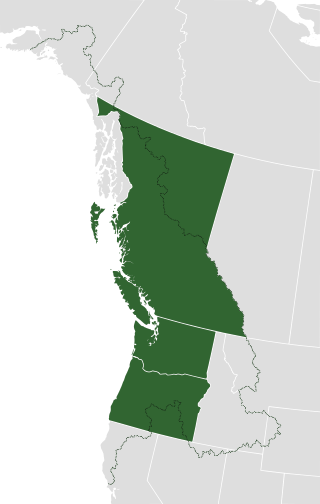
Cascadian independence resurged after the 2016 U.S. election and a secession referendum was proposed. Several political parties and organizations were formed a few years later.
Cascadians
Although there are no statistics on Cascadian demographics as a whole, roughly 67.5% of the population has European origins, while 8% is classified as “visible minority”—defined as “persons, other than aboriginal peoples, who are non-Caucasian in race or non-white in color”—and 3.5% as First Nations/Native Americans.
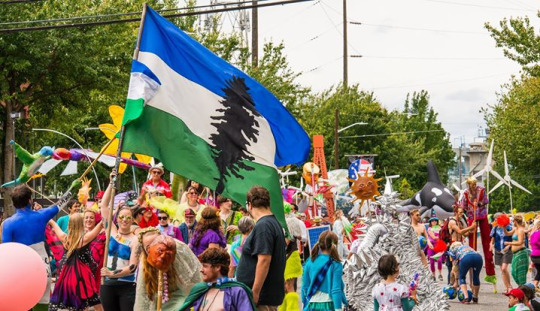
English is spoken by 89.6% of the population as a primary language. Christianity is practiced by 51.1% of Cascadians, while 38.7% are irreligious.
7 notes
·
View notes
Text

Water
I stumbled across this magazine at work. (I am employed by a community radio station in the Northwest.) I read the story about water and a Superfund Site in southern Oregon. Really, it's research for my Masters work for Mapping The System. My team is focused on how the changing climate, combined with ecological abuse has damaged our waterways, which ultimately impact our food supply. We will focus on the region of the US west coast, particularly the Cascadia Bioregion.
Yesterday, I had a meeting with a Harvard professor of hydrology and student of social innovation. More research.
Cascadia Stack, the company I am working to build is based on solarpunk ideals toward unity and harmony with nature. Climate adaptation, while reducing the effects of human activity.
Please follow to watch the progress.
4 notes
·
View notes
Text
wikipedia pages i have looked at recently
(since my browser history cuts off after 3 months)
feudalism
sark
guernsey
jersey
sercquiais
LGBT slang
list of pejorative terms for people
micronation
miso
declaration of war
sophie ellis-bextor
strictly come dancing (series 11)
the weather girls
it's raining men
leg shaving
craig charles
radclyffe hall
cicely mary barker
apennine mountains
gypsy horse
list of crossings of the atlantic ocean
titanic
scullery
dutch elm disease
pince nez
boston marriage
lutheranism
monocle
howards end
list of countries and dependencies by population
academic ranks in the united kingdom
mafia
bad bunny
amber alert
hue and cry
charabanc
list of feminists
skibidi toilet
dj snake
milan kundera
christmas market
darcey bussell
self esteem (musician)
roger eno
squeegee man
crossing sweeper
ramen
housewife
stay-at-home parent
Sally Clark
SIDS
Rabies
catacombs of paris
beaufort scale
religiosity and intelligence
korean variety show
variety show
osbournes reloaded
pine barrens
environment of united states
a walk in the woods (book)
terminal velocity
muzzle velocity
dehumidifier
withnail and i
vivian mackerrell
bruce robinson
2017-18 australian parliamentary eligibility crisis
orlando: a biography
medically unexplained physical symptoms
gulf war syndrome
list of paradoxes
opposite day
cascadia (bioregion)
appalachia
beano (dietary supplement)
idaho
ghost rockets
list of billboard hot 100 number one singles of the 2010s
list of uk singles chart number ones of the 2010s
list of most viewed youtube videos
cardiac tamponade
the spook light
will o' the wisp
atmospheric ghost lights
ball lightening
brown mountain lights
st elmo's fire
poltergeist
shadow person
estimates of historical world population
chin
dan and phil
east west rail
african cuisine
ornimegalonyx
marital rape
bras d'honneur
list of songs by taylor swift
dwarf elephant
bone china
ivory
wrangel island
mammoth
african elephant
last glacial maximum
ground sloth
3D film
nigella lawson
prehistory of australia
mastodon
paleoloxodon
borneo elephant
straight tusked elephant
hyrax
north african elephant
zoetrope
O holy night
containerization
shakira
list of antidepressants
list of poker hands
victoria coren mitchell
bikini
evergreen A-class container ship
i had a little nut tree
gunge
houses in multiple occupation
pedestrian crossings in the united kingdom
belisha beacon
coca-cola formula
demographics of south america
wasabi
flashed face distortion effect
aella (influencer)
temperate rainforest
caledonian forest
loch lomond
bigfoot
jedi census phenomenon
timeline of meteorology
centralia, pennsylvania
jersey devil
ozarks
crawler
blue hole (new jersey)
quantum suicide and immortality
the hum
skyquake
tubal ligation
glycerol
air source heat pump
list of current knights and ladies of the garter
list of prime ministers of the united kingdom
CP Snow
calabash
gourd
apocolocyntosis
1 note
·
View note
Text
Looking for a Cascadia Passport? Grab it here!
Department of Bioregion
A Cascadia Field Guide to Wheatpasting
December 29, 2018
A CASCADIA FIELD GUIDE TO WHEATPASTING
Tactics & Ideas
Cascadia Wheatpasting Header.jpg
AN EASY STEP BY STEP GUIDE TO WHEATPASTING
Like graffiti, wheatpasting is a direct action technique that is a simple, visual means for communicating messages to a large audience created by mixing, water, flour and sugar. Wheatpasting has been used as antiquities and can be as simple as 8.5x11 sheets of paper, or even smaller, 11x17 copies or printouts, or large print runs, or lots of individual sheets coming together to combine for a longer message or picture. Prints and copies can for a 8.5x11 will usually run 3-8 cents a sheet, while larger 11x17 sheets may run 4-10 cents for black and white, or quite a bit more for color. For larger print outs, it’s always good to ask around, and most any independent print shop can offer reasonable quotes.
View fullsize
60e4a833a06138ac0b3326ed58ef3dc7.jpg
Some larger pieces of wheatpaste can take up entire walls, or even billboards. Wheatpasting, like stickering and unlike graffiti, tends to fall into a legal grey area, because it is not permanent, does not use harmful chemicals, and is bio-degradable. If you would like to remain in this grey area - focus on public property - metal street signs, utility poles, utility boxes. Note that mailboxes constitute federal property and a felony offense, though some have actually found the USPS to be the nicest when reaching out about people wheatpasting on their property. People should make their own choices about bus stops - as they are public - but often it is the underpaid staff of Public transportation that has to clean them up.
If you size your pieces correctly, the back of stop signs, and other harder to reach places can yield long term results, and if you make your wheatpaste correctly, artwork can last for years even in the wettest and most damp conditions. If you want to double up your efforts, bring a staple gun.
In terms of ease, it always help to go with friends, especially tall friends, or take a small step ladder with you. 3 people tends to be optimal, where one person can hold the bucket and paint, one person can paint an under layer, another to slap it up, and then another to go over it again with another layer. You want to make sure the poster is thoroughly soaked all the way through with your wheatpaste mixture.
Disclaimer: Always check on your local laws and ordinances anywhere you might want to sticker, graffiti, or wheatpaste. The Cascadia Department of Bioregional Affairs takes no responsibilities of the actions for people who read this guide, and always recommends only that use wheatpaste in a legal, consentual manner.
Crafting your Poster
View fullsize
Free Cascadia Sasquatch Poster
Free Cascadia Sasquatch Poster
If you’re wheatpasting to express something specific, a good design is the key for getting your message across. Go big, go simple. Most people will see your poster from a distance, and the information must translate. So make the headline huge and legible and use images that are simple, high-contrast, and equally large. Most wheatpasting is done in black and white, so make sure to use high contrast colors, rather than a lot of shades or gradients. You can also include a paragraph or so in smaller print for the casually interested, and it’s always a good idea to add a web site address or similar link for those who want to pursue things further.
Don’t limit yourself to pasting up standard-size photocopies; many photocopying franchises offer much bigger options. You can make huge posters to put up; if such printing technology is unavailable, you can paste up big images comprised of smaller copies. This may seem counter intuitive, but the thinner the paper, the better—thin paper takes paste better, and will be more likely to rip off in tiny pieces rather than all at once if an art hater takes a dislike to it. Another way to foil such philistines is to run a razor quickly down and across each poster several times immediately after you’ve pasted it up; a pasted poster sliced in this manner will only come down one small piece at a time.
Recipe for Wheatpaste
WHAT YOU NEED:
Flour
Water
Sugar
5 gallon bucket with lid.
OPTIONAL:
Glitter
Non-toxic Glue
*Note* Multiply the ingredients to as much as you need. The below ingredients will make only a very little. It is also just one of about one million different recipes for wheatpasting so feel free to google, find your own recipe or find a good youtube video that works for you.
Wheatpasting is completely bio-degradable and non-toxic. We leave it on you if you want a ‘gluten free’ alternative.
Copy of 20171104_123520.jpg
Directions:
Begin boiling 2 cups of water
In a separate bowl mix 1 cup of water with 1 cup of flour
Beat the hell out of that flour and water. Use an egg beater if you have one and whip it until you’ve got as smooth of a consistency as possible.
Turn off the boiling water and pour in the mixed wheat paste.
Continue stirring.
Add 3/4 cup of sugar.
Continue stirring.
Make a lot of pancakes. Yum yum yum.
Dump into the 5 gallon bucket and add the non-toxic glue and the glitter (shiny!) if you want. Note that this is not necessary but may help the adhesive properties and texture of said wheat paste.
Continue stirring.
This whole process should take no more than half an hour, and it’s ready as soon as it done.
Best means of delivery:
We highly recommend getting a 5 gallon bucket with a lid. Wheatpaste will usually keep for around 3-5 days (until it begins fermenting and smelling awesome).
Best way to put up posters or artwork is usually using a paint roller or brush you can buy very cheaply from a hardware store.
Using a paint roller, throw down a basic layer of wheatpaste. Soak every spot that the flyer will cover.
Put up the flyer.
Now, using the brush or paint roller, soak that thing. You want to make sure you coat the entire thing your putting up, and especially get the edges.
Wheatpasting works best on metal, but also works fine on concrete or even brick surfaces.
Don’t forget to clean off your supplies when you get back before it has a chance to dry.
We find wheatpasting with a friend works great. One person can throw down a base layer while another puts up the flyer and helps get the edges. If you can get a few friends, divide up into a couple groups, each with a bucket and you can hit both sides of a street at once.
Enjoy, alter and adapt all of these directions as needed! Figure out what works best for yourself. We encourage everyone interested in stickering, flyering or wheatpasting in their neighborhoods to understand their local laws. This can usually be found with a quick google of your cities RCW laws. In most major cities in the Pacific Northwest, all of the above are COMPLETELY LEGAL, but may vary from area to area.
2af43846fbdf2662dd7309bc06775015.jpg
14201387348_28f497fd43_b.jpg
adda4820dd6ae5cbf5302a0212f8d90c.jpg
bioregions now.jpg
Cascadia Bioregions Now resiliency through community.jpg
cascadia dissent is patriotic.jpg
cascadia half sheets.jpg
Cascadia Little Doug Flags Wheatpaste.jpg
Cascadia Now largest events.jpg
Cascadia Now Listening In.jpg
Cascadia Now trash can.jpg
Cascadia posters.jpg
Cascadia Street Art Picture.jpg
Cascadia tree flag wheatpaste.jpg
Cascadia united agianst austerity.jpg
Cascadia Wheatpaste Fuck Yeah.jpg
Cascadia wheatpaste.jpg
Cascadianow 6500 strangers cant be wrong poster.jpg
Cascadianow and possibly tomorrow display.jpg
CascadiaNow and possibly tomorrow poster.jpg
cascadianow because fuck homophobic assholes.jpg
cascadianow did you know poster.jpg
cascadianow hipster sasquatch.jpg
Cascadianow poster at shop.jpg
cascadianow poster.jpg
CascadiaNow starts with the smallest actions.jpg
cascadianow the largest events start with the smallest of actions.jpg
cascadians against war poster.jpg
cut it out and restart cascadia.jpg
envision design reshape inspire.jpg
For the Sake of the Kittens Cascadia Now Street Art Graffiti.jpg
free cascadia sasquatch.jpg
free cascadia stickers pile.jpg
Free Cascadia Stickers.jpg
small steps lead to great actions.jpg
2af43846fbdf2662dd7309bc06775015.jpg14201387348_28f497fd43_b.jpgadda4820dd6ae5cbf5302a0212f8d90c.jpgbioregions now.jpgCascadia Bioregions Now resiliency through community.jpgcascadia dissent is patriotic.jpgcascadia half sheets.jpgCascadia Little Doug Flags Wheatpaste.jpgCascadia Now largest events.jpgCascadia Now Listening In.jpgCascadia Now trash can.jpgCascadia posters.jpgCascadia Street Art Picture.jpgCascadia tree flag wheatpaste.jpgCascadia united agianst austerity.jpgCascadia Wheatpaste Fuck Yeah.jpgCascadia wheatpaste.jpgCascadianow 6500 strangers cant be wrong poster.jpgCascadianow and possibly tomorrow display.jpgCascadiaNow and possibly tomorrow poster.jpgcascadianow because fuck homophobic assholes.jpgcascadianow did you know poster.jpgcascadianow hipster sasquatch.jpgCascadianow poster at shop.jpgcascadianow poster.jpgCascadiaNow starts with the smallest actions.jpgcascadianow the largest events start with the smallest of actions.jpgcascadians against war poster.jpgcut it out and restart cascadia.jpgenvision design reshape inspire.jpgFor the Sake of the Kittens Cascadia Now Street Art Graffiti.jpgfree cascadia sasquatch.jpgfree cascadia stickers pile.jpgFree Cascadia Stickers.jpgsmall steps lead to great actions.jpg
Tagged: Changelab, Wheatpasting, Tactics, street art, diy, cascadia, posters
Newer Post
Cascadia Subduction Zone Tremors: 36,377 in 2018
Older Post
The Practice of Bioregionalism: An Interview with Richard Evenoff
BE A DIPLOMAT
GET A CASCADIA PASSPORT
BE A MEMBER
STAY UPDATED BY EMAIL
Email Address
SIGN UP
Latest Posts
Your Chinook Wawa Word of the Day: Salal
YOUR CHINOOK WAWA WORD OF THE DAY: SALAL
Aug 2, 2021
Your Chinook Wawa Word of the Day: Shot Olallie
YOUR CHINOOK WAWA WORD OF THE DAY: SHOT OLALLIE
Jul 26, 2021
Your Chinook Wawa Word of the Day: Seahpo olallie
YOUR CHINOOK WAWA WORD OF THE DAY: SEAHPO OLALLIE
Jun 28, 2021
VERY HAPPY JUNETEENTH, CASCADIA!
Jun 19, 2021
Your Chinook Wawa Word of the Day: Amote
YOUR CHINOOK WAWA WORD OF THE DAY: AMOTE
Jun 14, 2021
flat.png
First Name
Last Name
Email Address
SIGN UP
Love Cascadia? Sign up for updates.
Archive | Contact Us | FAQ | Search | Share | Subject Index
Accessibility Statement | Copyright Information | Diversity and Inclusion | External Link Policy | First Nation Partnership | FOIA | No Fear Act | Partnership | Privacy Policy | Safe Space Policy
The Office of Website Management, Bureau of Cascadian Public Affairs, manages this site as a portal for information from the Cascadian Bioregion Department. External links to other Internet sites should not be construed as an endorsement of the views or privacy policies contained therein.
Note: documents in Portable Document Format (PDF) require Adobe Acrobat Reader 5.0 or higher to view, download Adobe Acrobat Reader.
BACK TO TOP
CONTACT
GET EMAIL
SEARCH
SHARE
Unless otherwise noted, content is Creative Commons Attribution-NonCommercial-ShareAlike 4.0 International (CC BY-NC-SA 4.0) license. Images and content by other authors are copyright. Please receive permission before use. We enjoy attribution and link backs. More information and full stipulations about our Creative Commons Licence, copyrighted material and use policy, can be found in our Copyright Policy Page.
#graffiti #blurb #blog #dump
#graffiti#flypasting#flyposting#legal#illegal#.doc#.docx#.txt.diary#.txt.legal#archive#.index#index#undated#txt
0 notes
Text
Almost impossible question 106.7 today

Almost impossible question 106.7 today how to#
Almost impossible question 106.7 today update#
Foie gras over potato chips? Eurotrash on Belmont. Barbecue jackfruit fried pie? Try Whiffies on Hawthorne. Whatever you’re craving, you can probably find it on sale at a parking lot in Portland. (Full disclosure – the filmmakers interviewed me, and you can actually hear me stuttering like Elmer Fudd just before minute 6 of the trailer.) Migee:Įditor’s note: Eric posted Seattle and Vancouver follow ups to this piece. The nature footage is gorgeous, and the message is worth listening to. If you’re a fan of bioregionalism, check out this Kickstarter project to help fund a film about Cascadia. Regardless, it’s a brilliant example of effective anti-branding: pithy, memorable, disgusting, and (for anyone who remembers school cafeteria lunches) believably evocative. It certainly doesn’t sound appetizing, but I don’t actually know. I have no particular opinion on whether “pink slime” is healthy. The product…is exposed to “a puff of ammonium hydroxide gas” to kill bacteria, such as E. The lean mix then is compressed into blocks for use in ground meat. The bits are heated to about 100 F and spun to remove most of the fat. The low-cost ingredient is made from fatty bits of meat left over from other cuts. Thank goodness: the USDA is allowing school cafeterias to opt out of serving “lean finely textured beef,” also known as “ pink slime.” But as the numbers clearly show, there’s less economic mobility in the US than in many other rich countries and most studies show that economic mobility is static or perhaps decreasing-though women may now be more upwardly mobile than men. Of course, the issue of economic inequality wouldn’t be so crucial if there was lots of economic mobility-that is, if people moved from the bottom to the top of the income ladder all the time.
Almost impossible question 106.7 today how to#
From the press release: “While toxicologists generally focus on animals exposed to a compound, work…demonstrates that diseases can also stem from older, ancestral exposures that are then mediated through epigenetic changes in sperm.” Ick!Ī short, readable guide to Tactical Urbanism: how to create mini-parks, greener streetscapes, safe places for kids to play in cities, and more!Īpparently, 2010 was a very good year to be in the 1 percent. WSU researchers find that exposure to toxic chemicals can affect the next three generations of offspring. Only one textbook received a worse grade this time around: Roger Miller’s Economics Today, 16 th ed. Not coincidentally, it has also earned the coveted 2012 Ruffin and Gregory Award for the Worst Treatment of Climate Change in an Economics Textbook. (Our previous review gave the 3rd edition a C+, describing it as “a masterpiece vandalized by hooligans”.) As a political aside, it is worth noting that Glenn Hubbard and Greg Mankiw, whose textbook also received a top grade, are the two economists advising Mitt Romney. As in 2010, some hit the mark while others are wildly misleading, but we’re happy to say that there’s plenty of good news: about half of the books improved their treatment of climate change.Įspecially noteworthy is Glenn Hubbard and Tony O’Brien’s Economics, 4th ed., which has jumped to the top of our list.
Almost impossible question 106.7 today update#
This spring marks the release of new editions of introductory economics textbooks, so it’s a good time to update our 2010 review of the treatment of climate change in economics textbooks.

0 notes
Text
Portland Fields Forever: Learning about a place through soccer, and about soccer through a place
When I travel I always look for fields. I find that soccer, and sports more generally, provide rich access points for understanding the cultural geography of a community — enacting a mix of the universal and the particular through the physical spaces and rituals around how people play. Soccer allows a traveler to look through the lenses of social science to learn about local meanings.** **
In past years I’ve used these lenses to learn about some far flung places, posting photo essays on Icelandic Fields Forever and Tanzanian Fields Forever. In 2022, with the start of a Fall academic semester teaching a class at the University of Portland on ‘The World Cup in Mind and Society’ (a cross-listed psychology and sociology class that also counts for the new ‘exploration level’ of our University Core Curriculum - offering students interdisciplinary opportunities to engage timely issues) I decided to turn those lenses on the community I share with my students: Portland, Oregon.
The idea was to help students explore the value of social science lenses by taking their own pictures of soccer in our town, and also finding publicly available material on the web that seems to say something about the meanings of soccer in Portland. The students initially did this individually, ideally connecting their findings to the types of psychological and sociological questions social scientists might ask, and then we put them together for a discussion of the patterns and meanings.
I started them off with an old Timbers Army tifo as an example of how much symbolism is embedded in a kind of display rarely seen anywhere except at major sporting events:

(Photo from soccer.nbcsports.com)
Only one of the students in the class is actually from Portland, and none of the students recognized the Portland city flag on the left or the Cascadia flag on the right — with the Portland flag representing the green forests and intersecting rivers of the Willamette and Columbia, while the Cascadia flag (aka, “the Doug”) was designed to symbolize the bioregion of the western Cascades that runs from western Oregon through western Washington and up to Vancouver, British Columbia.(and adopted by the region’s soccer fans as a cultural identity - and even sometimes as a claim to nation-like status) The students also didn’t recognize the face of Clive Charles in the middle — but they do know his name quite well, since it adorns our campus stadium. The broader point: soccer offers a rare space to display local pride, tribute historical icons, and identify with a region (the presence of the Cascadia flag contrasted with the absence of a US flag is meaningful here!).
The professional game and its accompanying fan base then became one of four entry points we identified for the cultural geography of soccer in Portland, accompanied by school soccer, club soccer, and recreational soccer. Each involves multiple levels of meaning — some that would be similar anywhere in the world, some that are more characteristic of American soccer writ large, and some that might be particular to Portland.
On the fandom side of things, for example, we agreed that Portland’s support for the Portland Thorns in the NWSL has elements of the universal — in the tendency of fans to don colors, scarves, and team merch that creates a feeling of shared identity — and the particular — in the implicit emphasis on gender empowerment embodied by Portland’s particularly vociferous support for the women’s game.

(Photo from Oregonlive.com)
And, speaking of scarves, one student contributed a shot of a campus dorm room decorated with scarves that situate Portland fandom amidst a melange of global soccer — tributing the Thorns and UP icon Megan Rapinoe alongside the USA, Chelsea, and the Tiburones (maybe referring to a small Mexican club?).
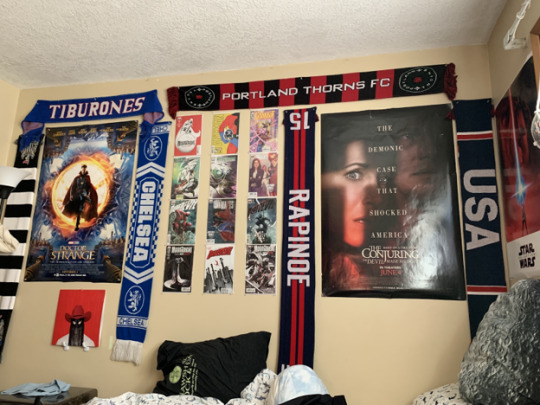
(Photo by student Kimberly Cortez)
The “Rapinoe” scarf here, even if not tied explicitly to her UP alumni status, also connects to the curious phenomenon of college soccer in the US — and the fact that schools such as the University of Portland rely heavily on sports to try to build community and communal identification. Take, for example, the Villa Drum Squad — a residence hall based tradition at UP that has long created a supporters' culture around both the men’s and women’s soccer teams at UP, while also creating their own ‘annual soccer derby’ to establish bragging rights (and reinforce communal identities?) between residence halls.
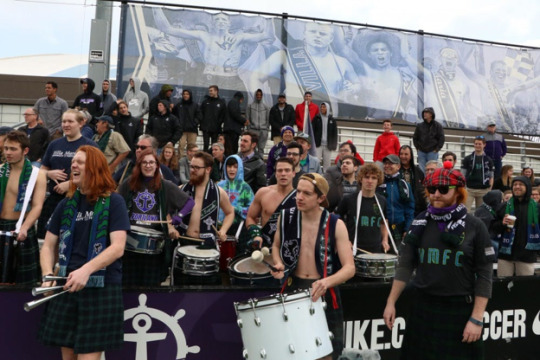
(Photo by Jeffrey Braccia from The Beacon, identified by student Declan McGinnis)
We also talked about college soccer at a place such as UP as an interesting space for bringing international students to diversify our community, and as a place where gender inequities still seem to loom - despite the historic success of the UP women’s team. Yet the men’s and women’s players themselves support each other and build their own community at the games - as per the creative photo taken by a student superimposing a polaroid of some of the women’s players watching the a men’s game.
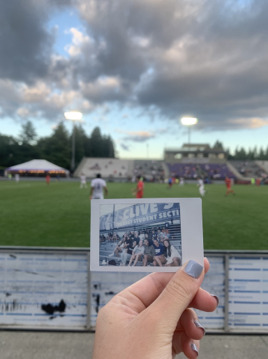
(Photo by a student with a preference for no attribution)
The general idea of playing at a place such as UP as a potential end goal for young players is another distinctive feature of American soccer culture, and one that is changing over time as club soccer has professionalized. As a scholar of youth development, I have some concerns about the trend to send 12 or 14 year olds to mythical ‘national championship’ tournaments and about the broader disconnection of American soccer from an educational mission. But the students are less concerned than I — finding pictures that mostly celebrate the joy young Portlanders get from the game.

(Photo from Timbers.com, identified by student Justin Tucker)

(Photo identified by student Charlie Ma)
Which then brings us to recreational soccer — an all-ages category that takes place all over town in lots of forms, usually with a distinctively American touch of commerce and structure. Several students, for example, have worked with the ‘Soccer Shots’ program that introduces very young kids to the game through a fun (but also structured and programmed) version of street soccer.

(Soccer Shots at the playground; Photo by student Henry Ryde)
Others work with local recreational soccer programs that sometimes serve as feeders for higher level clubs, and sometimes function just as an end point for the less talented or less serious players. One was involved with a season-opening Fall jamboree, and snapped a picture that seems vividly symbolic of youth soccer American style — where even the ‘pick-up’ games are programmed with signage, bags of balls, pre-set cones, and more equipment than players (though I was assured the players did come later!).
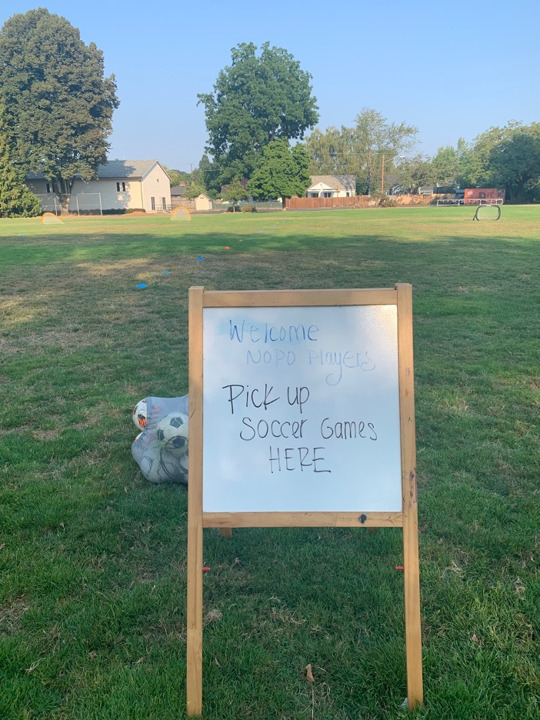
(Photo by student Kelli Coughlin)
The structure and programming also hints at another particular characteristic of American soccer — the pay-to-play model that commercializes what might otherwise be a public good. One student saw this in a photo of the empty turf field available for rent at a local business park:
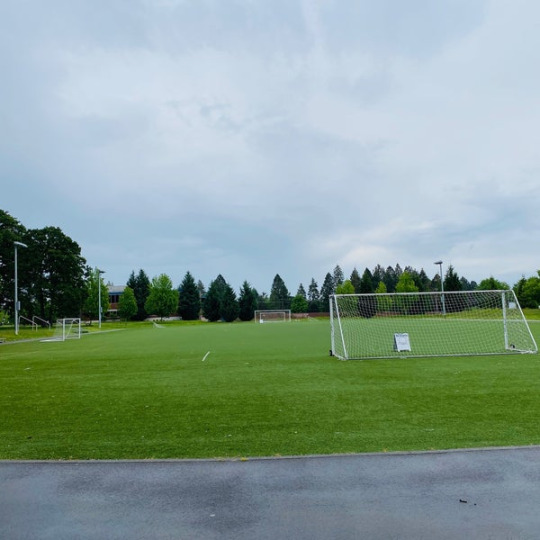
(Photo by student Braden Williamson)
Fortunately, Portland does also share with the rest of the world a few places where a player can just drop in to a game for whatever reason moves them on the day: exercise, community, mental health, the thrill of competition, or any of the many possibilities embedded in my favorite universal symbol — a ball and a field…
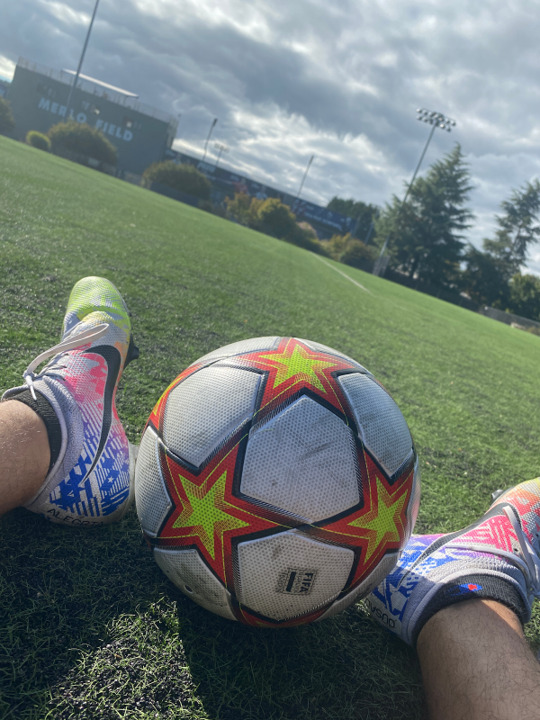
(Photo by student Cole Saldana)
0 notes
Photo
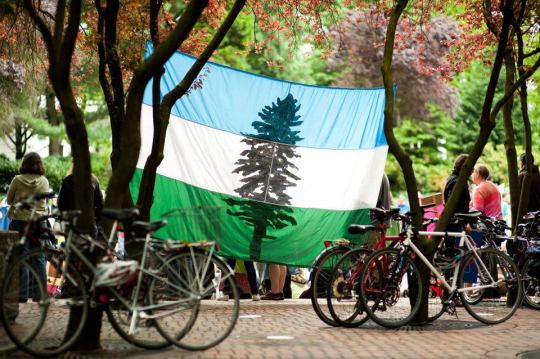
Missing Portland
1 note
·
View note
Photo

resident (cottontail; genus: Sylvìlagus)
rooster rock, columbia river gorge
june 15, 2022
this rabbit had a little companion a bit further along the edge of the vining blackberry; both of them sharing a space with the men lounging nude among the sharp grasses. the columbia river had flooded and submerged the entirety of the beach, and the human residents who usually lounge on that pale crescent of sand were pushed back into the thorns and bushes usually only frequented by the rabbits, chipmunks, thrushes, sparrows, and woodpeckers. the place was more subdued than usual, our bodies perhaps aware on some level of being interlopers on this part of the land. immediately west of the cottontails, a man sat reading a book about sailboats, while another lounged in a hammock strung between two hardy, twisted shrubs. their movements were slow; their gazes soft.
i have noticed that upon spotting a rabbit in the wild, a hush will fall over all who are present. something happens in our nervous systems when we encounter other beings: our living bodies begin to co-regulate with the bodies of the wild creatures around us, with the breath of the air in the trees and the shifting sunlight glowing and blinking out like sparks within the leaves. i think we will tend to match the nervous system of the animal we encounter, so a hush falling over a group that is connecting with a rabbit makes sense, whereas making eye contact with a steller’s jay is a more lively experience, as they behold you with their exacting, somewhat chaotic, gaze.
as for spotting rabbits: you are unlikely to see cottontails on windy days - the wind blows through their tall ears and obscures their hearing, and because they are prey for nearly every predator you can imagine, they will stay huddled together in their burrows until they once again have full faculty of their senses. for a prey animal known for their skittishness, i’m often surprised by how leisurely their flight can be. these rabbits regarded us for quite awhile, only hopping away when another person came down the path, and even then their flight had a somewhat lazy air to it. you’re most likely to see them at the hours of dusk and dawn, and if you see one it’s more than likely that there are a few more a little ways off. because we saw them around a blackberry thicket, it’s quite possible we were close to their burrow, as they tend to make homes in these places.
i’ve never seen a rabbit when i’ve been looking for one, though - i think you have to let them surprise you.
#rabbit#cascadia bioregion#cascadia census#pnw#pnwonderland#pacific northwest#oregon#Columbia River Gorge#rooster rock#cottontail
0 notes
Text
Register now: Generative writing class inspired by the Cascadia Field Guide (Saturdays in August, Online)
For more info & to register: https://hugohouse.org/product/writing-with-the-cascadia-field-guide/
Writing with the Cascadia Field Guide, with instructor Sierra Nelson
Class Description: Dive into the poems, art, and naturalist insights in Cascadia Field Guide: Art, Ecology, Poetry — learning about fascinating creatures and plants living in "Cascadia" (the bioregion stretching from Alaska to California, land and ocean). Then we'll generate our own writing (open to any genre) using in-class prompts inspired by the readings and diverse authors. Your own writing can connect to any ecosystem; you don't have to live in Cascadia. You'll leave this class with deepened wonder, new drafts, and a reinvigorated creative process.
Discount code offered for book purchase.
Term: Summer 2023
Start Date: August 5, 2023
End Date: August 26, 2023
Day of Week: Saturday
Time: 1:10pm - 3:10pm PT
Level: Open to all levels
Audience: Adult
Location: Online (via Zoom)

#sierra nelson#hugo house#cascadia field guide#poetry#ecology#art#cascadia#generative class#writing class#creative writing#nature#creatures#plants#sea creatures
1 note
·
View note
Photo
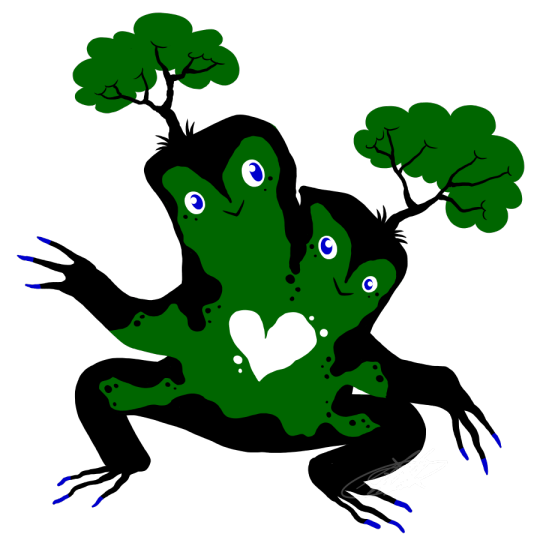
NAME: Doug
PALETTE: Cascadia (Bioregion Flag)
MONSTER: Despite having two heads, Doug only seems to have a singular personality. He likes to wander around the forests of Cascadia, caring for the trees and munching on sticks and pebbles.
Requested by @silver-wolfheart
Commentary and links under cut!
COMMENTARY: A bioregion flag, a second first! :D The flag’s colors aren’t really my cup of tea, especially not the heavily saturated deep blue. I think I just don’t like that particular color unless in very specific circumstances XD It makes my eyes ache. But, the do enjoy the particular shade of green they selected! I think it goes well with the rich forestry of the Cascadia region. Speaking of which, did you guys know how big that region is?? Wild!
LINKS:
Patreon - https://www.patreon.com/MOGAI_Monsters
Redbubble - https://www.redbubble.com/people/MOGAI-Monsters?asc=u
Join the Monster Mash! - https://discord.gg/SAKXamA
30 notes
·
View notes